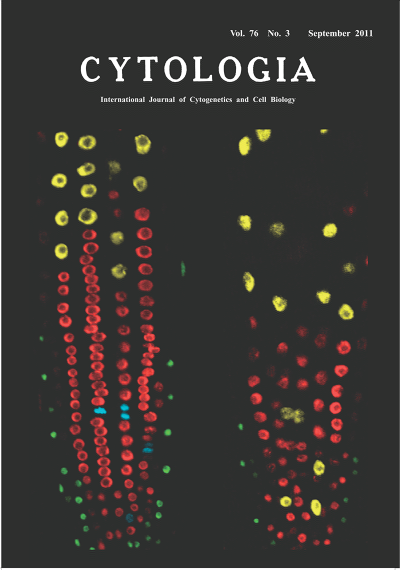| ON THE COVER |  |
|---|---|
| Vol. 76 No.3 September 2011 | |
| Technical note | |
|
|
|
| DNA Double-strand Breaks Induce Endoreduplication Damaged DNA needs to be repaired to prevent loss or incorrect transmission ofgenetic information. Eukaryotic DNA damage checkpoints delay or arrest the cell cycle to provide time for DNA repair before the cell enters a new round of DNA replication or mitosis. Comparative sequence analyses among plants, yeast and animals indicate that some of the factors involved in DNA damage checkpoint and DNA double-strand breaks (DSB) repair systems are conserved between vertebrates and plants. In animals,polyploidy is usually observed in particular cell types, such as follicle and nurse cells during oogenesis in Drosophila, and trophoblast giant cells during placental development in rodents. It also occurs upon mitotic catastrophe; for example, some cancer cells exposed to anti-mitotic drugs undergo endomitosis. In contrast, polyploidization is a normal part of the Arabidopsis thaliana developmental program; for example, mature leaf cells display elevated DNA ploidy levels of up to 32C as a result of endoreduplication. We found that A.thaliana treated with DSB inducers displayed increased cell size and DNA ploidy without a concomitant change in chromosome number. This endoreduplicative response indicates that it is a unique programmed mechanism for plants to survive under genotoxic stress. Pictured are two Arabidopsis root tips, mock-treated (left) or treated with zeocin (right), an inducer of DSBs. The roots are expressing histone H2B fused with a red fl uorescent protein; blue, yellow and green pseudo-colors represent chromosomes in mitotic cells, nuclei in endoreduplicated and root cap cells, respectively. We showed that DSBs induce endoreduplication and reduction of cell numbers derived from cell expansion. See the article by Adachi S, Minamisawa K, Okushima Y, Inagaki S, Yoshiyama K, Kondou Y, Kaminuma E, Kawashima M, Toyoda T, Matsui M, Kurihara D, Matsunaga S and Umeda M. 2011: Proc. Natl. Acad. Sci. U S A. 108: 10004–10009. (Sachihiro Matsunaga1 and Masaaki Umeda2 1Department of Applied Biological Science, Faculty of Science and Technology, Tokyo University of Science, 2641 Yamazaki, Noda, Chiba 278–8510, Japan. 2Graduate School of Biological Sciences, Nara Institute of Science and Technology, 8916–5 Takayama, Ikoma, Nara 630–0192, Japan.) |
|